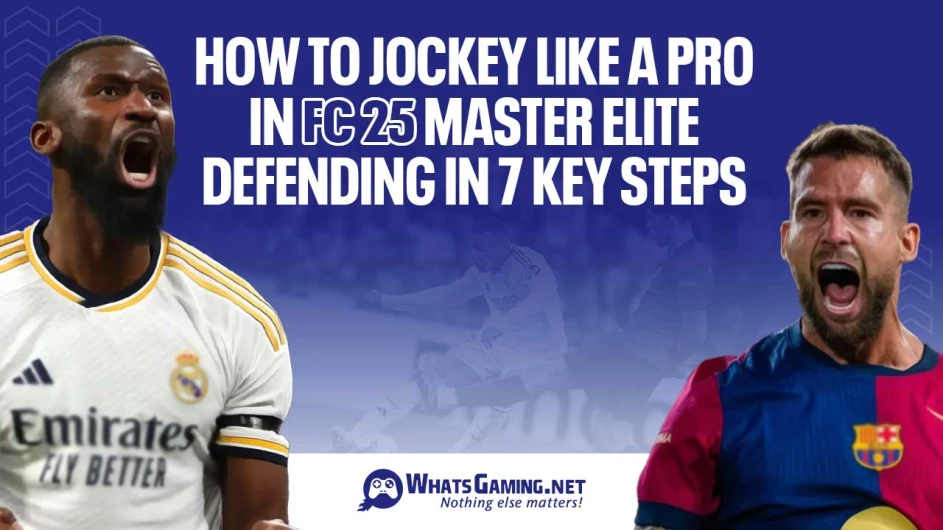
How to Jockey Like a Pro in FC 25: Master Elite Defending in 7 Key Steps
- 1. Understanding the Core of Jockey Defending
- 2. Anticipation: Your First Defensive Superpower
- 3. Avoid “Biting” and Rushing Into Tackles
- 4. Reading Body Language and Movement Patterns
- 5. Running Jockey vs. Slow Jockey: Knowing When to Use Each
- 6. Mirroring the Attacker With Controlled Movement
- 7. Mastering Passive-Aggressive Jockeying
- Bonus: Know Your Opponent’s Traits and Shooting Tendencies
- Conclusion: Jockeying Separates Average from Elite Defenders
Many players in EA Sports FC 25 struggle with defending, blaming unresponsive defenders or overpowered attackers. But here’s the truth: if your jockeying feels clunky or ineffective, the problem isn't your defenders it’s your technique. Jockey defending is the most important mechanic when it comes to winning 1v1 duels, and learning how to master it can completely transform your defensive performance.
In this detailed guide, we’ll break down 7 crucial subtopics that will teach you how to jockey like a pro. From reading your opponent to knowing when to use slow or fast jockey, every aspect is explained step-by-step. Whether you're battling in Division Rivals or grinding FUT Champs, mastering these techniques will help you win the ball with confidence and consistency.

1. Understanding the Core of Jockey Defending
Jockey defending is a mechanic that allows you to contain attackers by closely tracking their movement. It keeps your defender square to the ball carrier, helping you maintain balance and prevent being easily dribbled past. When used correctly, it’s your first line of defense, especially in isolated 1v1 situations where one mistake can cost you a goal.
Unfortunately, many players misuse jockeying by overcommitting or using it at the wrong time. This leads to awkward animations, lunges, and total loss of defensive control. To truly become a master defender in FC 25, you need to understand the philosophy behind jockeying — it’s not about constantly holding buttons, it’s about knowing when to move, when to stay still, and when to engage.
2. Anticipation: Your First Defensive Superpower
Anticipation is the bedrock of effective jockeying. Too often, players get caught lunging in or chasing shadows because they fail to read the attacker’s next move. Good defenders are proactive, not reactive. They position themselves in ways that limit what the attacker can do, cutting off passing lanes or forcing them into less dangerous areas of the pitch.
You won’t always guess correctly, and that’s okay. But even when you guess wrong, smart anticipation lets you stay in the play. Think about tendencies: does your opponent favor their dominant foot? Are they looking to cut inside or sprint down the line? The more you play — and the more you watch others play — the better your instincts become. Over time, anticipation turns into muscle memory, helping you jockey smarter without hesitation.
3. Avoid “Biting” and Rushing Into Tackles
One of the most common defending mistakes in FC 25 is “biting” — rushing toward the attacker and hitting the tackle button too early. While it might work occasionally, this reckless approach often triggers bad tackle animations, leaving your defender out of the play and completely exposed.
Instead, be patient. Use jockeying to stay in front of the attacker and only attempt a tackle when you’re close enough and have full control. Timing is everything. Lunging from a distance makes you look like a “headless chicken,” as many pros say. Tackling is still important, but it must come from calculated, close-range
defending, not desperate attempts.
4. Reading Body Language and Movement Patterns
Every attacker in FC 25 gives away subtle hints about their intentions. Watch their body angle, pace, and direction changes. For example, if a left-footed player begins angling inward on their left, chances are they’ll try to cut in for a finesse shot. Your job as a defender is to recognize those signals and block off their preferred route.
But don’t overcommit to the read. If you completely sell out to stop the left foot, a smart attacker can take one touch to the right and leave you for dead. It’s about balancing awareness with control — shading their strong side while still staying flexible enough to recover. The best defenders are like chess players: always two moves ahead, never overextending.

5. Running Jockey vs. Slow Jockey: Knowing When to Use Each
FC 25 gives you two main jockeying styles: running jockey (L2+R2 / LT+RT) and slow jockey (L2 / LT only). Each serves a different purpose. Running jockey is ideal when covering large areas, cutting off passes, or pressing opponents while still having backup defenders behind you. It’s fast and effective for defending with numbers.
Slow jockey, on the other hand, is essential when you’re in a 1v1 situation or when the attacker is close. It gives you tighter control and better balance, making it harder for attackers to glide past. When someone is dribbling around the box, switching to slow jockey lets you mirror their movement accurately. Using both methods in the right context is what makes elite defenders so hard to beat.
6. Mirroring the Attacker With Controlled Movement
Mirroring is the art of copying your opponent’s every move, step for step. Instead of lunging or guessing, you simply react to what they do. If they go left, you go left. If they hesitate, you hesitate. This forces attackers to work harder for space and often leads them into making mistakes or taking poor touches.
In FC 25, mirroring works best with slow jockeying. It’s especially useful against tricky players with five-star skill moves, as they can switch directions quickly. By mirroring, you stay square and centered, always ready to block or steal the ball. It’s a psychological battle too — when attackers see they can’t shake you, they start forcing plays, and that’s when you strike.
7. Mastering Passive-Aggressive Jockeying
One advanced tactic top defenders use is passive-aggressive jockeying. It involves moving back and forth between pressure and retreat jockey in, jockey out. When you press up, you show aggression and challenge space. When you pull back, you invite the attacker forward, creating a baiting trap.
This back-and-forth rhythm keeps the attacker guessing. They’re never sure if you're about to step up for a tackle or drop to contain them. It’s a mind game that buys you time and control. If you want to watch this in action, look at how players like Kroos defend they don’t chase, they bait. Master this technique and you’ll start dictating the attacker’s decisions instead of reacting to them.
Bonus: Know Your Opponent’s Traits and Shooting Tendencies
Player traits matter in FC 25. If an attacker has a low-driven shot trait or finesse shot trait, they become more dangerous in tight spaces. Recognizing this lets you adjust your defending — staying tighter on dangerous players and being more cautious about giving them room inside the box.
By knowing what your opponent’s player can do, you’ll be less likely to get caught off guard. The more familiar you are with popular meta attackers and their abilities, the better you’ll position yourself. It’s another form of anticipation, but this time it’s based on in-game knowledge and scouting, not just reactions.

Conclusion: Jockeying Separates Average from Elite Defenders
Jockey defending is the gateway to becoming a truly elite player in FC 25. It’s not a flashy skill, but it’s the foundation of every successful defense. Mastering anticipation, choosing the right jockey style, and learning how to mirror and bait attackers will make you an incredibly hard player to break down.
Next time you're defending in FUT Champs or Rivals, focus on your jockeying be patient, stay composed, and think a few steps ahead. These skills won’t just help you win more matches, they'll change the way you approach the entire game. Want to defend like a pro? It all starts here.
We will share more updates on FC 25 in separate articles. If you found this information helpful or would like to learn more, please be sure to explore the other articles on our site.
Why the 4-4-1-1 is Dominating FC 25: Tactics, Tips & Setup
Antony Matheus dos Santos – TOTS Honourable Mentions: Player review



